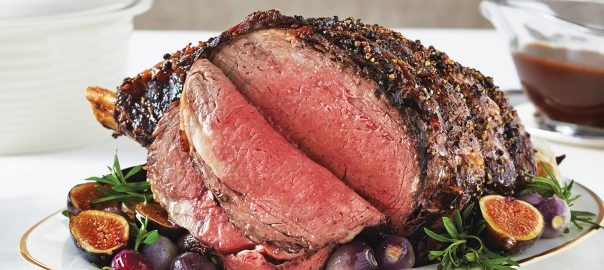
Choosing the Best Cuts of Beef
Tips and Advice for Choosing Great Cuts of Beef
All around the world, beef is one of the most popular kinds of meats used for a vast array of recipes and different styles of cuisine. Of course, it’s easy to see why. It’s a versatile meat to cook with and can provide very different results depending on the method of cooking, and the cut of beef that is used in the recipe. However, things can easily go awry if the cooking method and the cut of beef don’t line up with their best use case scenarios. If you’re not careful, you could end up with a tough, leathery piece of meat, and that’s not going to please anyone. So how do you make sure that you’re choosing the best beef for your desired recipe?
There are many different things to consider when choosing the right cut of beef for a particular use. These factors include what part of the cow the beef comes from, how much or how little fat there is on the beef, how you intend to cook it, and more. In this article, we explain the different kinds of beef that are available, as well as how the different styles of cooking will dictate what the best cut of beef is for that particular method. Choosing the right cut for your recipe is easy, as long as you keep these rules in mind. First, let’s start by taking a look at the different kinds of beef that you may find at your butcher shop.
Kinds of Beef
There are several different ways that beef is categorized and graded. The first consideration we will look at is the common grading system used by the USDA to indicate the level of quality of a particular cut of beef. The USDA scale of beef generally starts with Select as the most common level of grading. Beef that is deemed to be of higher quality is marked as Choice, and the finest grades of beef are marked as Prime. There are many factors that are considered in determining the correct grade for beef, including marbling of fat within the meat, thickness and consistency, and visual appearance.
In addition, you will likely see reference to the breed of cattle beside each type of beef as another indicator of its properties. The most common type of cattle used for beef in North America is the Angus, which can only be called Angus if it meets very specific breeding criteria. In addition, you can also find beef imported from other regions of the world such as the British Herefordshire, the Italian Piedemontese, and the Japanese Waguyu types of cattle.
Common Cut Styles for Beef
Regardless of the type of cattle used or the grade of the meat, the styles of cut used to describe the shape, size, and source of the beef are the same across all kinds. Here, we will describe the different cuts, and list the styles of cooking and preparation they are best suited for.
Steaks
This is a unique category, in that there are many different types of beef that are considered to be ‘steaks’, and each has their own unique characteristics.
Filet mingon is one of the most common steaks and is a circular cut of beef with no bones that is taken from the tenderloin, which gives it a delicious melt-in-your-mouth experience when prepared correctly.
T-bone steaks are aptly named due to the t-shaped bone embedded in them, which gives them a unique look and helps to keep the meat moist. The porterhouse is generally larger than the t-bone but is very similar in style as they both come from the short loin area. Strip steaks also come from the short loin and can be found in boneless or bone-in styles.
Other popular styles of steak include flat-iron steak (cut from the shoulder area), top sirloin (cut from the top muscle of the short loin), skirt steak (cut from the diaphragm muscle), rib eye (cut from the rib area), and hanger steak (cut from the short plate, similar to the skirt steak).
Steaks are most commonly prepared on a grill, and then served fresh alongside a wide variety of side dishes, or they can also be sliced and used as an ingredient in other recipes. Many people choose to season their steaks with a wide range of spices, seasonings and rubs. Brands such as Summer Kitchen and Hot Mamas offer many different kinds of seasonings that are perfect for steaks. You can choose from hot and spicy blends, savoury flavours, or perhaps even something sweet if the mood strikes you. Here at The Low Carb Grocery, we offer a full selection of delicious steak seasonings and spice rubs.
Roasts
Beef that is intended to be roasted, broiled, or prepared using ovens, slow cookers, smokers or other cooking devices is generally cut in much larger sections than beef intended for grilling.
Eye of round and bottom round roasts are generally inexpensive and are very versatile cuts of beef, ideal for a basic roast beef dinner. They are usually prepared using a low-and-slow cooking method to tenderize the meat and produce an enjoyable meal when sliced. Other roasts with similar characteristics to eye of round and bottom round are top sirloin, sirloin tip, and top round roasts. These are all perfectly suited for oven roasting and slicing thin for a variety of uses.
For the finest cuts of beef for roasting, people generally opt for cuts such as the rib eye, tenderloin, or tri-tip, all of which produce a more flavourful final result. Tri-tip and shoulder roasts can also be prepared on the grill, adding some other preparation options to choose from.
Beef Cuts for Stewing or Frying
When the beef is intended to be simmered as part of a stew or fried quickly as part of a stir fry, you can choose from many different cuts to achieve a delicious end result. For recipes that call for longer cooking times, perhaps prepared in a slow cooker or crockpot, you can use beef chuck or round roasts for excellent results. If your recipe is more of a stir fry style, you’d be better served to use a thinly sliced steak such as a sirloin, rib eye, or top loin. These cuts are more tender and will produce better results with the higher temperatures and shorter cooking times associated with wok and stir fry cooking.
Other Uses for Beef
Aside from grilling, roasting, simmering and frying, beef can also be used in other dishes such as casseroles, tacos, burritos, meatballs, chili, shepherd’s pie, and many more types of foods. In these instances, it’s common for ground beef to be used, but depending on what is used to create the ground beef, the fat content will vary. Normally, this is indicated with certain terminology on the packaging of the ground beef, such as medium, lean, or extra lean ground beef, in order of decreasing fattiness. While there is very little difference in the beef itself once it is cooked, there will be a substantial difference in the amount of fat to be drained as you compare a medium ground beef to an extra lean ground beef. If you require plenty of drippings for sauces or gravy, then you may want to avoid overly lean ground beef as it will not produce much of it. For more information on making a great gravy, check out our guide to low carb gravy and sauces.
Conclusion
As you can see, there is lots of variety in the world of beef which is a big part of the reason why it is such a common meat around the world. It’s versatility to create a diverse range of tastes and textures makes it the perfect source of protein in countless recipes in cuisine of all types. Now, the next time you head to the butcher shop in search of the perfect grilling steaks for your next barbecue, or perhaps a nice roast for a big family holiday meal, you’ll be better equipped to navigate the offerings of beef behind the counter and make a great choice that everyone will love. Keep these tips in mind, and you’ll end up with the perfect cut of beef, every time.






